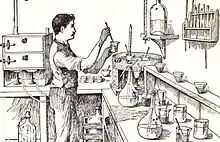淡香水
淡香水(Eau de toilette)是一類氣味較為輕微的香水。[1][2][3]也常被稱作“芳香水”并含有一定量的酒精。[4]通常會直接在沐浴後塗抹於皮膚上。[5][6]

不同品牌的瓶裝淡香水
淡香水命名時常會加上其中的主要成份,例如天竺葵水中的天竺葵、薰衣水中的薰衣草等。[7]因為常用花作為原料,因此也常被稱作“花香水”。[8][9][10][11]
歷史
14世紀波蘭的伊莉莎白(1305-1380)發明了一種混合酒精的芳香油來塗抹皮膚。[12]這大約就是“匈牙利水”,即最早的淡香水,[13]也是古龍水的前身。[14]傳說年屆七十且身體欠佳的女王在使用了這種香水後竟恢復了健康。此外,匈牙利水還含有迷迭香成份。[15]
酒精

配製香水,1910年
一般會使用一些溶劑來溶解香油,但其必要性存在爭議。而大多數溶劑都是乙醇或乙醇與水的混合物,乙醇也可以起到擴散劑的作用,使得香水的香味更容易被人嗅到。相對含有3-5%芳香油、80-90%的酒精和15%的水的古龍水來說,淡香水的酒精濃度低得多,一般只有60-80%,而芳香油則一般有2-8%。[16]因此也被當做是一種稀釋過的古龍水或濃香水。[17][18]傳統上古龍水都含有柑橘油和芳香物質,但淡香水並沒有類似要求。[19][20]
健康
一些淡香水被認為可以滋潤皮膚並有一些其他的醫療價值。[21][22][23] 1905年的《Medical Record》曾報導說噴灑淡香水可以恢復人們的精力。[24][25] 14至16世紀有一類淡香水被認為有驅除黑死病的功效。[13][26]
參見
參考資料
- The Free Dictionary definition
- MacMillan Dictionary
- Cambridge Advanced Learner's Dictionary definition
- Cristiani, p. 117
- toilet water term meaning
- Distinguishing Colognes, Perfumes, Scents, & Toilet Waters
- Ebert, p. 304
- Lawless, p. 39
- Baker, p. 262
- Fettner, p. 102
- Cox, p. 118
- Sherrow, p. 125 King Louis XIV (1638-1715) had his shirts scented with toilet water that included aloewood, rosewood, orangle flower, musk, and spices. The concoction was called "heavenly water" ...
- Stoddart, p. 154
- Müller, p. 348
- The History of Perfume 的存檔,存档日期2015-02-08.
- Groom, p. 329
- eau de toil definition from the online Free Dictionary
- Thesaurus online dictionary
- Grolier, p. 154
- Consumer reports, pp. 409-411
- Better Nutrition magazine, Nov 1999, p. 34
- Hiss, pp. 918-919
- Frank, p. 414
- Dewey, p. 55
- Interstate druggist, Volume 7, page 333
- Dictionary of Traded Goods and Commodities, 1550-1820 by Nancy Cox and Karin Dannehl
參考文獻
- Baker, William Henry, A dictionary of men's wear..., W. H. Baker, 1908
- Better Nutrition magazine, Nov 1999, Vol. 61, No. 11, ISSN 0405-668X, Published by Active Interest Media, Inc.
- Consumer reports, Volumes 25-26, Consumers Union of United States, 1960
- Cox, Nancy C., Perceptions of retailing in early modern England, Ashgate Publishing, Ltd., 2007, ISBN 0-7546-3771-9
- Cristiani, Richard S., Perfumery and kindred arts: A comprehensive treatise on perfumery, H. C. Baird, 1877
- Dewey, Willis Alonzo, Medical century, Volume 14, Medical Century Company., 1906
- Ebert, Albert Ethelbert, The Standard formulary, G.P. Engelhard & Co., 1897
- Fettner, Ann Tucker, Potpourri, incense, and other fragrant concoctions, Workman Pub. Co., 1977, ISBN 0-911104-97-6
- Grolier, The New book of knowledge, Grolier, 1986, ISBN 0-7172-0517-7
- Groom, Nigel, The new perfume handbook, Springer, 1997, ISBN 0-7514-0403-9
- Hiss, A. Emil, The new standard formulary:, G.P. Engelhard, 1910
- Müller, Peter M., Perfumes: art, science, and technology, Springer, 1994, ISBN 0-7514-0157-9
- Sherrow, Victoria, For appearance' sake: the historical encyclopedia of good looks, beauty, and grooming, Greenwood Publishing Group, 2001, ISBN 1-57356-204-1
- Stoddart, David Michael, The scented ape: the biology and culture of human odour, Cambridge University Press, 1990, ISBN 0-521-39561-5
This article is issued from Wikipedia. The text is licensed under Creative Commons - Attribution - Sharealike. Additional terms may apply for the media files.
